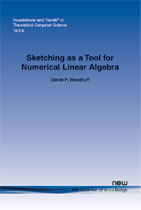Sketching as a Tool for Numerical Linear Algebra
By David P. Woodruff, IBM Research Almaden, USA, dpwoodru@us.ibm.com
Abstract
This survey highlights the recent advances in algorithms for numerical linear algebra that have come from the technique of linear sketching, whereby given a matrix, one first compresses it to a much smaller matrix by multiplying it by a (usually) random matrix with certain properties. Much of the expensive computation can then be performed on the smaller matrix, thereby accelerating the solution for the original problem. In this survey we consider least squares as well as robust regression problems, low rank approximation, and graph sparsification. We also discuss a number of variants of these problems. Finally, we discuss the limitations of sketching methods.
Sketching as a Tool for Numerical Linear Algebra
Sketching as a Tool for Numerical Linear Algebra highlights the recent advances in algorithms for numerical linear algebra that have come from the technique of linear sketching, whereby given a matrix, one first compressed it to a much smaller matrix by multiplying it by a (usually) random matrix with certain properties. Much of the expensive computation can then be performed on the smaller matrix, thereby accelerating the solution for the original problem.
Sketching as a Tool for Numerical Linear Algebra considers least squares as well as robust regression problems, low rank approximation, and graph sparsification. It also discusses a number of variants of these problems. It concludes by discussing the limitations of sketching methods and briefly looking at some open questions.
Sketching as a Tool for Numerical Linear Algebra is an ideal primer for researchers and students of theoretical computer science interested in how sketching techniques can be used to speed up numerical linear algebra applications.
